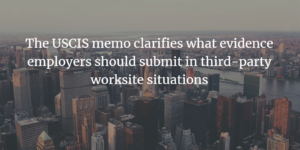
Effects of the USCIS Policy Memo on Employers Filing H-1B Petitions With Third-Party Worksites
 This February, The United States Citizen and Immigration Services (USCIS) updated its guidelines relating to H-1B petitions involving third-party worksites. The third-party worksite arrangement is common in some industries, especially the information technology industry.
This February, The United States Citizen and Immigration Services (USCIS) updated its guidelines relating to H-1B petitions involving third-party worksites. The third-party worksite arrangement is common in some industries, especially the information technology industry.
In order to approve an H-1B petition, USCIS must determine whether the beneficiary will be employed in specialty occupation work, and whether an employer-employee relationship exists between the petitioner and beneficiary. The USCIS memo explains that it can be difficult to reach these determinations when the beneficiary is assigned to work at a third-party worksite. The USCIS memo clarifies what evidence employers should submit in third-party worksite situations.
The list below provides some insight as to what evidence is required to receive an H-1B approval:
- H-1B petitioning employers need to provide contracts, work orders and letters from all parties involved in the third-party worksite arrangement. The USCIS memo requires vendors and end-clients to provide more documentation than they have in the past. For example, contracts and work orders between the vendor and end-client should be provided to USCIS.
- The less parties involved in the third-party worksite arrangement, the better. The memo explains that when additional parties are involved in the third-party worksite arrangement, the weaker the relationship between the petitioning employer and the end-client becomes. It then becomes difficult for the USCIS to determine the employer-employee relationship, and whether the position is a specialty occupation. The following situations are common in third-party worksite H-1B filings.
- Situation 1 (ideal): A direct contract between the petitioning employer and the end-client.
- Situation 2 (less ideal): Contractual agreements between the following entities: petitioning employer – vendor – end client.
- Situation 3 (least ideal): contractual agreements involving multiple vendors or implementation partners between the petitioning employer and end-client.
- H-1B petitions will only be approved for the amount of time for which there is guaranteed specialty occupation work for the beneficiary. The petitioning employer needs to submit evidence, such as work orders, contracts and letters, which confirm the beneficiary will perform specialty occupation work for the entire duration of requested H-1B period. If the petitioning employer provides work orders that expire within one year, then it is likely that the H-1B petition will be approved for only one year. Also, the memo clarifies it is not sufficient for work orders, contracts, or letters to contain speculative language such as “extensions are likely.”
The USCIS policy memo puts greater responsibility on third-party placement employers by expanding the documents required to obtain H-1B approvals.
